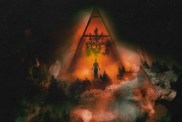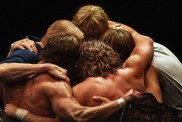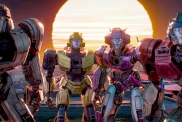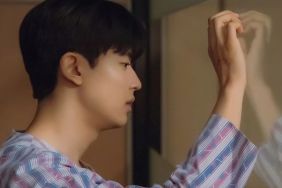
I’ve seen Cloud Atlas and I will admit, seeing Jim Sturgess made up to “look” like an Asian is a bit weird, just as it is with Hugo Weaving and James D’Arcy in the pictures above. It’s equally odd to see Halle Berry and Doona Bae made up to look Caucasian and is just as jarring to see Weaving dressed up like a muscular female nurse at a retirement home. The focus at the moment, however, is not on those latter looks, but the former as seen in the images above. Whether it’s considered weird, odd or jarring, the question is, is the use of yellowface in today’s cinema okay?
In a piece at Jezebel, Laura Beck was offended while watching the trailer for Cloud Atlas writing:
Hugo Weaving and Jim Sturgess, white actors, play characters who in some lifetimes are East Asian. So, of course, they just had them perform those roles with their eyes taped to make them look, “Asian.”
[…]
[M]y personal guess is that [directors Andy and Lana Wachowski and (though she ignores his involvement completely) Tom Tykwer] were probably like, “It’s the same soul, so we need the same actor, race doesn’t matter!” That’s the issue with inherent bias, though. You’re not necessarily coming from a nasty place, but the end result is still pretty much garbage.
Beck then hands off duties to Mike Le from Racebending.com who makes a good argument for why it is a problem:
In watching the Cloud Atlas trailer, the parallels are clear. As with these other films, we see that white creators and performers are permitted to determine what it means to be Asian. It’s frustrating, because the trailer suggests a story that comfortably meshes with preconceptions and stereotypes of Asians: of a futuristic world of high technology and little soul, where the “all-look-same” vision of Asianness is directly translated into racks of identical, interchangeable Asian “fabricant” clones. It suggests a world where white actors (in yellowface) and Asian actresses enter into romantic trysts — while excluding the voices and faces of Asian American actors.
I’d first like to take a look at this line from Le: “[T]he trailer suggests a story that comfortably meshes with preconceptions and stereotypes of Asians: of a futuristic world of high technology and little soul, where the “all-look-same” vision of Asianness is directly translated into racks of identical, interchangeable Asian “fabricant” clones.”

I fully admit I have not read David Mitchell’s novel from which the film is based, but it is my understanding the future world Le is referring to is presented the same way in the book as it is in the film. And on this one particular point, I have to say, if the intent is for clones to look the same then to say it is forwarding a stereotype is a bit of a stretch. They are clones, a defining nature of which is that they will all be the same. The location in which that portion of the film is set is Seoul, Korea… Does it not stand to assume the clones would be Asian?
Yes, alternatives can be thought of such as setting that portion of the film in New York and using any race but Asian, or going the Blade Runner route in which multiple models of Replicants were used. But I think to focus on this narrative aspect of the film is to skirt the larger issue.

When it comes to the decision to make-up Jim Sturgess (as well as Hugo Weaving and James D’Arcy) in “yellowface”, I can fully understand the frustration. Hollywood films are, by and large, dominated by white actors and a chance comes along to cast Asian actors in prominent roles in a big budget film and, instead, the decision is made to cast white actors and apply makeup to make them “look” like they’re Asian.
Why the decision?
The argument here is to point to one of the film’s themes and the idea our lives are connected and our souls live on through time. It’s my understanding, in the book the connected souls across time are handled through the use of a birthmark. In the film it’s handled by using the same actors.
Cloud Atlas is ambitious in that it attempts to tie six stories together spanning approximately 250 years and in doing so, using the same actors in each moment in time is an easy identifier for the audience, letting us know we’re looking at the same character, or, in this case, soul. As a result we are left to explore the changes that soul takes from one life to the next.
After watching the film, one could easily argue the use of the same actor in each moment in time is unnecessary. If the tying together of the souls was so important, it could have been achieved just easily and more subtly using the birthmark idea and dissolving from the birthmark on a character from one moment in time to the next. It wouldn’t have been as obvious as using Tom Hanks with fake teeth to Tom Hanks with a comb-over, but it would have tied the characters together through their actions rather than their appearance.
After all, one character verbalizes the larger narrative theme at one point asking, “Why do we keep making the same mistakes?” and I’d argue the connection of the souls is hardly as important as one generation making the same mistakes as the one before.

Oddly enough, just considering the possibility of an alternative presentation of the material has made me second guess my review after seeing it in Toronto. My problem with the film from the start was how each segment of the story seemed redundant from one to the next. The use of the same actors in each was a large part of this.
Cloud Atlas is on point with the presentation of a continued social structure over the course of time in which the powerful lord over the meek. The way it is carried out may not be the same from one era to the next, but the pattern continues. We all know we are a product of the times we live in, our experiences and what we take away from those before us. This idea is explored in Looper and another Toronto Film Festival entry, The Place Beyond the Pines. If art reflects life, there is obviously an undercurrent going around where we are looking at our history and finally coming to the conclusion change is necessary.
Watching Cloud Atlas, I took a mental note of the use of yellowface, but said nothing of it, thinking to myself, Well, I guess if their goal was to interpret these characters as the continuing of souls across time it had to be done that way. Looking at it now, did it have to be done that way and is it wrong to question the way in which it was done or for people to be offended by it?
Mike Le hits it on the head when he writes:
We cannot judge what the Wachowski siblings intend to do with their depiction of Asian people any more than we could judge what M. Night Shyamalan intended in casting The Last Airbender. The intentions may be different, but acts of exclusion and discrimination cannot be about intent, but only about outcome.
To me this is Le asking filmmakers to take a greater responsibility in the way they depict race in their art. He isn’t throwing stones as much as raising a red flag. It’s interesting, too, to read Le’s article and note how much it reflects the theme of Cloud Atlas itself, as one character says, “Why do we keep making the same mistakes?”
FURTHER READING: RaceBending.com offers a history of “yellowface” in cinema from the early 1900s to present day right here that is well worth a look.









